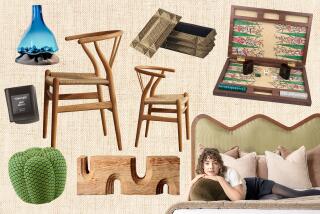Wright’s Popularity Soars 30 Years After Death : Architecture: Interest in furniture and accessories designed by Frank Lloyd Wright on upswing. Museums plan retrospectives.
Frank Lloyd Wright liked to furnish the homes he built, thus assured that nothing in his carefully executed designs was left to chance.
While the architect’s works were reviled by many during his lifetime, they are enjoying an unprecedented revival more than 30 years after his death.
Tourists are flocking to the public buildings and private residences he built, such as Hollyhock and Ennis-Brown houses in Los Angeles, and the seemingly countless items of furniture and home accessories attributed to him continue to grow.
Although you couldn’t give away his furniture for some years, copies now manufactured in Italy and marketed in the United States by Atelier International sell at prices into five figures. Tiffany & Co. does a thriving business in reproductions of crystal, silver and china. Schumacher has introduced Frank Lloyd Wright fabric, wall coverings and rugs, and Oakbrook-Esser Studios of Oconomowoc, Wis., fabricates art-glass windows.
Beyond the works of Wright himself, his influence on others seems to be growing. There are 40 books on Wright in print, says Richard Carney, managing trustee of the Frank Lloyd Wright Trust of Scottsdale, Ariz.
“I see a tremendous number of designs that are either influenced by or copied from Mr. Wright,” he says.
Most of the copies are faithful reproductions, but one might wonder what Wright himself would think of an avalanche of other items, such as note paper, T-shirts and jewelry identified with the Wright name, which are sold via mail order and at Wright museums.
Besides the avalanche of product offerings, buildings are being restored and museums are scurrying to stage retrospectives. David Hanks of New York, a museum curator, has organized several exhibitions, including one that will open at the Chrysler Museum in Norfolk, Va., in November. The Museum of Modern Art in New York has announced plans for a major retrospective in 1994.
Meanwhile, prices for original furnishings escalate in antiques shops and auction houses.
After a prolific career that spanned 70 years, is it possible that Wright’s influence and his designs are more widely dispersed 31 years after his death?
“I think so,” Carney says.
According to Hanks, Wright believed a home should offer a feeling of repose and that indoor and outdoor environments should be in harmony. These thoughts and his love for Japanese art and for natural wood--he often used beautifully grained wood such as oak--are much appreciated today, he says.
Atelier distributes reproductions of Wright’s best-known furniture, such as the Barrel Chair and Robie and Taliesin chairs. Prices range from $1,200 for a side chair to $14,000 for a large dining table. That may seem pricey, but not compared to the $1.6 million recently paid for an original dining set.
In addition to the “Imperial” china, Tiffany offers the more informal “Cabaret” pattern. Also in its Frank Lloyd Wright collection is a terra-cotta vase and crystal vases, candlesticks and a candy dish. Prices range from about $100 to $300. This fall, Tiffany’s is introducing some sterling silver accessories.
These companies, along with Schumacher and Oakbrook-Esser, are licensed by the Frank Lloyd Wright Foundation. Since the licensing program began in 1986, the number of products has grown substantially, according to Steve Kroeter, who oversees all licensing applications.
“We started with seven pieces of furniture,” Kroeter says. “Now there are 13. And over the next five years, there will be two more collections, each with three to six pieces. More rugs have been introduced, and two new windows will be added this fall.”
For those who want to browse through the home furnishings reproductions, an updated product catalogue will be available in September for $8.50 from The Frank Lloyd Wright Catalogue, P.O. Box 5599, Stacy, Minn. 55079.
For those who want to wander through some of his original architecture, start in Oak Park, Ill., the Chicago suburb that is a mecca for Wright aficionados. His home and studio built in 1889 at 951 Chicago Ave. is now a museum and national historic site open for tours. Another two dozen structures are within walking distance. Brochures are available at the museum or the Oak Park Visitor’s Center, 158 Forest Ave. On the third Saturday in May, the Frank Lloyd Wright Home and Studio Foundation, to raise funds, opens several of the private residences to ticket holders.
More to Read
The biggest entertainment stories
Get our big stories about Hollywood, film, television, music, arts, culture and more right in your inbox as soon as they publish.
You may occasionally receive promotional content from the Los Angeles Times.










